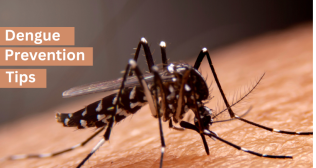
All You Need to Know About Bronchiolitis: Symptoms, Diagnosis, Treatment
Introduction
Bronchiolitis is a common respiratory illness primarily affecting infants and young children. It mainly occurs during the winter months when the tiny airways in the lungs, called bronchioles, are infected by some viruses, including Respiratory Syncytial Virus (RSV), Influenza Virus, Adenovirus, Parainfluenza, Metapneumovirus, and SARS-CoV-2.
Understanding bronchiolitis symptoms, diagnosis, and treatment options is crucial for parents and caregivers to manage this condition effectively. While it also affects older children and adults, bronchiolitis usually occurs in infants and toddlers.
How Does Bronchiolitis Affect the Body?
During bronchiolitis, the respiratory system undergoes several changes. Here’s a breakdown of these changes:
- The inflammation narrows the airways and restricts the airflow.
- The inflammation triggers mucus production that further blocks the narrowed airways.
- The obstruction of the airways and impaired gas exchange leads to decreased oxygen levels in the blood.
Symptoms of Bronchiolitis
The symptoms of bronchiolitis are similar to that of a common cold, such as a runny or stuffy nose, coughing, sneezing, and sometimes a mild fever. However, as the illness progresses, it leads to more severe respiratory symptoms. These symptoms include:
- Wheezing: Wheezing is a high-pitched whistling sound that occurs when air struggles to pass through narrowed airways.
- Rapid or Labored Breathing: Infants with bronchiolitis may exhibit rapid breathing or retractions, that is, visible movements of the chest wall or abdomen during breathing due to blocked airways.
- Difficulty Feeding: Due to respiratory distress and increased effort required for breathing, infants with bronchiolitis experience challenges in feeding and refuse to eat.
- Irritability or Lethargy: Bronchiolitis can cause discomfort and fatigue in infants, leading to increased irritability or lethargy.
- Cyanosis: In severe cases, bronchiolitis can result in cyanosis, a bluish discoloration of the skin and mucous membranes due to inadequate oxygenation of the blood.
It is essential to monitor infants closely for these symptoms, especially if they are at higher risk for complications, such as premature infants or those with underlying medical conditions.
Diagnosis of Bronchiolitis
Healthcare providers use various tools for bronchiolitis diagnosis, including a clinical evaluation, physical examination, and assessment of the infant’s symptoms.
- Medical History: Healthcare providers will inquire about the infant’s medical history, including any recent illnesses or exposure to sick individuals.
- Physical Examination: During the physical examination, healthcare providers will listen to the infant’s lungs using a stethoscope to assess for abnormal sounds such as wheezing or crackles.
- Pulse Oximetry: Pulse oximetry is a non-invasive test that measures the oxygen saturation of the blood. It involves placing a sensor on the infant’s finger or toe to monitor their oxygen levels.
- Chest X-ray: In some cases, the doctor orders a chest X-ray to evaluate the severity of lung involvement and rule out other respiratory conditions.
- Nasal Swab: A nasal swab is performed to test for viral pathogens, such as respiratory syncytial virus (RSV), the most common cause of bronchiolitis.
Treatment of Bronchiolitis
Bronchiolitis treatment is primarily supportive, aimed at relieving the symptoms and ensuring adequate hydration and oxygenation. Depending on the severity of the illness, the treatment plan may include:
- Hydration: It is essential to ensure that infants with bronchiolitis remain adequately hydrated, as respiratory distress can lead to increased fluid loss through breathing. Frequent breastfeeding or formula feeding and monitoring for signs of dehydration, such as decreased urine output or dry mucous membranes, is essential.
- Oxygen Therapy: Infants with severe respiratory distress or low oxygen levels might require supplemental oxygen therapy. This treatment is administered using nasal prongs or a face mask as needed.
- Nasal Suctioning: Nasal congestion can worsen respiratory symptoms in infants with bronchiolitis. Gentle nasal suctioning using a bulb syringe or saline drops can help clear mucus and improve breathing.
- Bronchodilators: Bronchodilators help relax the muscles around the airways and improve airflow. However, their effectiveness in treating bronchiolitis is limited, mainly for infants with severe respiratory distress or a history of reactive airway disease.
- Corticosteroids: In some cases, corticosteroids are prescribed to reduce airway inflammation and swelling. However, their effectiveness against bronchiolitis remains controversial.
- Antibiotics: Since viral infections cause bronchiolitis, antibiotics are ineffective and should not be used unless there is evidence of a bacterial co-infection.
- Humidifiers: Using a cool-mist vaporizer or humidifier at home helps loosen mucus in the airway and relieve cough and congestion. However, the apparatus should be cleaned regularly to prevent mold or bacteria buildup. Steam humidifiers cause scalding and should be avoided.
- Hospitalization: Infants with severe bronchiolitis or those unable to tolerate oral fluids may require hospitalization for close monitoring and supportive care. In the hospital setting, intravenous fluids and respiratory support, such as continuous positive airway pressure (CPAP) or mechanical ventilation, may be necessary.
Is Bronchiolitis Contagious?
Viral infections primarily cause bronchiolitis. These viruses are highly contagious. Infants and young children are particularly susceptible to bronchiolitis due to their immature immune systems and smaller airways, which can become easily obstructed by inflammation and mucus. Environmental factors, such as exposure to cigarette smoke or air pollution, may also increase the risk of bronchiolitis. The condition mainly occurs during the first two years among infants with premature babies, children with lung or heart problems, and infants with weak immune systems being most at risk.
Recognizing the symptoms of bronchiolitis, obtaining a timely diagnosis, and implementing appropriate treatment are essential for managing this condition effectively. By providing supportive care, ensuring adequate hydration and oxygenation, and closely monitoring respiratory status, healthcare providers can help infants recover from bronchiolitis and prevent complications. Additionally, promoting measures to reduce the spread of respiratory viruses, such as hand hygiene and avoiding close contact with sick individuals, can help prevent bronchiolitis in the first place.



















